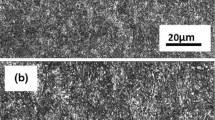Abstract
Some important characteristics of the cyclic creep-rupture curves have been studied for the titanium alloy 6Al-2Sn-4Zr-2Mo at 900° and 1100°F (755 and 865 K), the cobalt-base alloy L-605 at 1180°F <910 K), and for two hardness levels of 316 stainless steel at 1300°F (980 K). Such curves have been used successfully in a previous investigation for the evaluation and prediction of strain-cycling life at elevated temperatures within the creep range. The cyclic creep-rupture curve relates tensile stress and tensile time-to-rupture for strain-limited cyclic loading and has been found to be independent of the total strain range and the level of compressive stress employed in the cyclic creep-rupture tests. The cyclic creep-rupture curve was always found to be above and to the right of the conventional (constant load) monotonic creep-rupture curve by factors ranging from 2 to 10 in time-to-rupture. This factor tends to be greatest when the creep ductility is large. Cyclic creep acceleration was observed in every cyclic creep-rupture test conducted. The phenomenon was most pronounced at the highest stress levels and when the tensile and compressive stresses were completely reversed. In general, creep rates were found to be lower in compression than in tension for equal true stresses. The differences, however, were strongly material dependent.
Similar content being viewed by others
References
S. S. Manson:Int.J. Fracture Mech., 1966, vol. 2, p. 327.
S. S. Manson and G. R. Halford:Proc., Int. Conf. on Thermal and High-Strain Fatigue, p. 154, The Metals and Metallurgy Trust, London, 1967.
G. R. Halford and S. S. Manson:Trans. ASM, 1968, vol. 61, p. 94.
D. A. Spera:NASA TN D-5317, 1969.
D. A. Spera:NASA TN D-5489, 1969.
S. S. Manson, G. R. Halford, and D. A. Spera:Advances in Creep Design (A. E. Johnson Memorial Volume), A. I. Smith and A. M. Nicolson, eds., p. 229, Applied Science Publishers, Ltd., London, 1971.
S. S. Manson, G. R. Halford, and M. H. Hirschberg:Design for Elevated Temperature Environment, p. 12, Am. Soc. Mech. Engrs., New York, 1971. (See also,NASA TM X-67838, 1971.)
M. H. Hirschberg:Am. Soc. Testing Mater. Spec. Tech. Publ. 465, 1969, p. 67.
G. R. Halford:NASA TN D-6309, 1971.
R. W. Swindeman:Proc., Joint Int. Conf. on Creep, p. 3–11, Inst. Mech. Engrs., London, 1963.
J. Morrow and G. R. Halford:Proc., Joint Int. Conf. on Creep, p. 3–43, Inst. Mech. Engrs., London, 1963.
M. Kitagawa: TAM Report No. 319, University of Illinois, Urbana, October 1968.
Author information
Authors and Affiliations
Rights and permissions
About this article
Cite this article
Halford, G.R. Cyclic creep-rupture behavior of three high-temperature alloys. Metall Trans 3, 2247–2256 (1972). https://doi.org/10.1007/BF02643239
Received:
Issue Date:
DOI: https://doi.org/10.1007/BF02643239



